
From the Gulf Coast to the Panhandle, there are plenty of places to choose from when building a new home in Texas. There’s something for everyone in the Lone Star State. Want to relax in the water with friends and family? We recommend floating the Comal or Guadalupe Rivers. Military history buffs in the family? Point them toward The Alamo or the U.S.S. Lexington. And if you’re looking for a quiet spot to live off the grid, well, Texas has plenty of land available.
With so many options it can feel overwhelming to decide where to buy your new home. To help, here at the 10 best places to live in Texas:
1. San Angelo, Texas
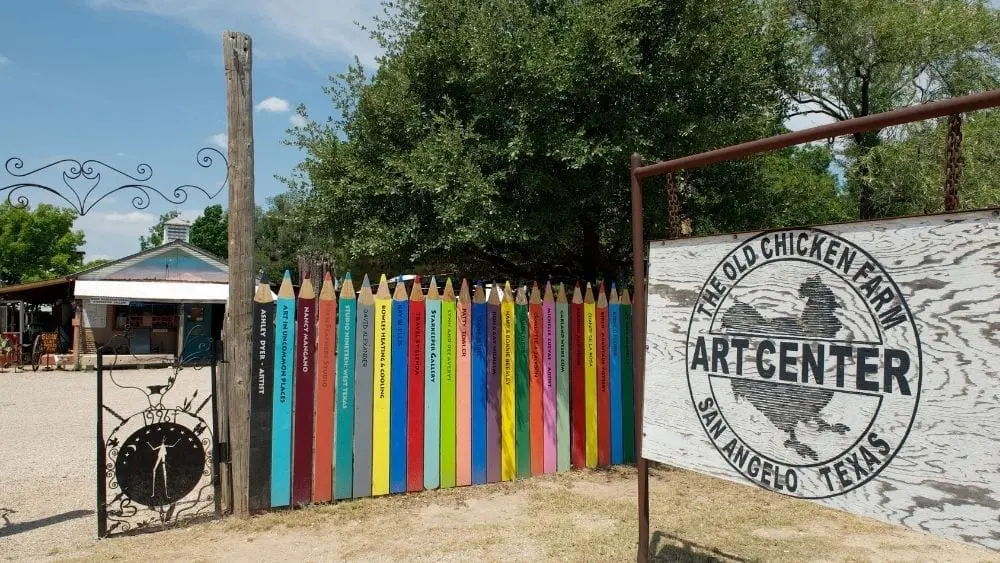
- Housing cost to income ratio: 2.18%
- Average childcare cost to income ratio: 0.94%
- Violent crime index: 21.3
- Nonviolent crime index: 58.9
- Cost of living index: 81.6
San Angelo, Texas is an oasis in the drylands of West Texas. Any of San Angelo’s 250 sunny days can be spent floating the Concho River, or fishing and boating on any of the three surrounding lakes. This West Texas city is home to more than 100,000 people.
The city has a strong economy that is supported by a variety of industries, including manufacturing, healthcare, and education. Some of the key players boosting the economy include major employers like Goodfellow Air Force Base, Shannon Health System, and Angelo State University. Live in the county seat of Tom Green County or one of its welcoming suburbs.
San Angelo is also a popular tourist destination, with attractions such as the San Angelo Museum of Fine Arts, Fort Concho National Historic Landmark, and the International Waterlily Collection. The San Angelo Museum of Fine Arts features a collection of over 12,000 works of art, including paintings, sculptures, and ceramics. Learn some rich history at the former military post, Fort Concho National Historic Landmark. Discover the beauty of 300+ varieties of waterlilies from around the world.
San Angelo State Park has over 50 miles of trails to explore. Many families hold family reunions at this park with its abundant activities. Along with hiking, you can ride horses, geocache, swim, fish and boat on the lake and river.
Hungry? Find your share of Tex-Mex, barbecue and other cuisine. Some local restaurants sure to satisfy any hunger include Mi Tierra Café & Panaderia, Pecan Lodge, The Mustard Seed, and Central Texas BBQ. From friendly staff to satisfying meals, these restaurants will fill your belly.
The climate allows for ample outdoor exploring year-round, with only 23 inches of rain and 1 inch of snow per year. The city is moderately conservative politically but prides itself on the friendly and diverse atmosphere in its neighborhoods. This welcoming energy is what makes San Angelo one of the best cities for entrepreneurs and business owners to launch their companies.
San Angelo Independent School District along with private schools like San Angelo Christian Academy and Trinity Lutheran School offer enriching curriculum for your children. There are at least 9 colleges serving the area, including 5 private colleges and universities, 1 public college or university, and 3 community colleges offering 2-year degrees. Angelo State University is known for ranking on the nation’s top 25 “Best Online Colleges”.
There are several hospitals in the area making it senior-friendly. Shannon West Texas Memorial Hospital and Concho Valley Regional Hospital are two offering exceptional healthcare. San Angelo also provides public transportation that makes stops citywide, including in suburbs like Riverside, Lake View, and PaulAnn.
There are several new homes in the San Angelo area with a variety of floor plans. Begin your search here and see why this part of the state has a special allure.
2. El Paso, Texas
- Housing cost to income ratio: 2.53%
- Average childcare cost to income ratio: 1.21%
- Violent crime index: 22.1
- Nonviolent crime index: 30.6
- Cost of living index: 81.4
Sharing a border with Mexico, El Paso is one of the largest majority Hispanic cities in the United States. Known as Sun City, it is sure to give outdoor lovers the perfect conditions for any activity; it is saturated with 297 sunny days annually, and only receives 10 inches of rain and three inches of snow. El Paso is a vibrant city located at the western tip of Texas, on the border with Mexico. It is the sixth-largest city in Texas and the second-largest city on the U.S.-Mexico border. El Paso is a diverse city with a rich history and culture that is influenced by its Mexican and American heritage.
Outdoor recreation includes great hikes or bike rides at the Franklin Mountains State Park. This expansive park has over 100 miles of trails for outdoor enthusiasts. Try to adventure the 1000 Steps Trail. Take an evening drive on Scenic Overlook and see the sprawling views of El Paso and Ciudad Juarez. Butterfield Trail Golf Club designed by Tom Fazio will have you setting frequent tee times. Take a day trip to Juárez, Mexico, which is just across the border from El Paso.
If you are looking for an escape from the heat, stop in at one of the 12 branches of the El Paso Public Library whose service crosses the borders of New Mexico and Mexico. Check out the vast collection of the El Paso Museum of Art or the El Paso Holocaust Museum and Study Center.
Families make memories at the El Paso Zoo. With an array of cultural events and festivals, there is always something to do in El Paso. The beautiful balloons dot the desert sky at the El International Paso Balloon Fiesta with 500+ balloons from around the world. The annual parade, The El Paso Dia de los Muertos Parade, celebrates the Mexican Day of the Dead holiday. Another holiday celebration is the El Paso Cinco de Mayo Festival.
El Paso has a diversified economy that is supported by several major industries, including healthcare, manufacturing, the military, and tourism. Major employers in this city include Raytheon, Delphi Automotive, Fort Bliss, and the University of Medical Center of El Paso. Another strong employer is the well-equipped hospital, Texas Tech University Health Sciences Center El Paso.
There’s a unique culinary cuisine in El Paso. Local vendors sell fresh produce and wares at the El Paso Downtown Farmers Market. You will also find delicious restaurants offering both Tex-Mex and authentic Mexican cuisine. For fine dining try Taft Diaz and Anson Eleven. The Good Luck Café will always impress with its delicious meals.
El Paso is served by the El Paso Independent School District, which is the fourth-largest school district in Texas. Find your choice of private schools in the city, including Cathedral High School, El Paso Christian School, and St. Clement’s School ready to meet your children’s needs. El Paso is home to a few colleges and universities, including The University of Texas at El Paso, El Paso Community College, Sul Ross State University El Paso and Texas Tech University Health Sciences Center El Paso.
El Paso’s politics are moderately liberal, and its residents are always welcoming to newcomers. Anywhere you choose to live, El Paso residents will make you feel at home. If you don’t know where to start, check out suburbs like San Ysidro, Mesila, and Las Cruces. When you are ready to live in a vibrant and diverse Texas city filled with history, culture, food and activities, the Sun City will be an excellent choice. Find your next new home in El Paso!
3. Abilene, Texas

- Housing cost to income ratio: 2.91%
- Average childcare cost to income ratio: 1.34%
- Violent crime index: 28.7
- Nonviolent crime index: 57.4
- Cost of living index: 79.3
Abilene is the Storybook Capital of America! The large collection of storybook sculptures adds to Abilene’s charming atmosphere and brings people from all over the country to visit. This West Texas city is home to 125,000 people.
Along with the whimsical attractions, Abilene is also ranked in the top 10 cities for remote workers. It is also known for its short commute times. Residents in Abilene spend about eight minutes less on their daily commute than the average American. The diversified economy is supported by healthcare, education, manufacturing, and military industries. Some of the key players for employment include Hendrick Health System, Dyess Air Force Base, General Dynamics, American Greetings, and 3M.
With this extra time, you may find yourself looking for something to do. Luckily, Abilene has plenty of activities like hunting, fishing, museums, and sporting events to keep you entertained. And with yearly averages of 243 sunny days, 26 inches of rain, and a mere three inches of snow, you won’t need to worry about Mother Nature interfering. Bike or walk the Abilene Loop Trail with over 20 miles of paved trails.
There are ample museums including the Eisenhower Presidential Library and Museum. Learn more about the story of Dwight D. Eisenhower’s life and presidency. Take a tour of the Frontier Texas! museum, which features interactive exhibits on the history of Texas and the American West. Check out the collection of art at the Grace Museum. Take advantage of seeing a show at the historic Paramount Theatre.
Families love visits to the Storybook Capital of America®, which features a collection of over 100 bronze sculptures of characters from children’s books. The Abilene Zoo is home to 1,000+ animals from round the world. Don’t miss the Abilene Zoo’s Zoo Boo for fun trick-or-treating, costume contests, and other Halloween-themed activities. Additionally, Abilene hosts events and festivals throughout the year, including the Dyess Air Force Base Open House and Air Show, the Abilene Christmas Parade, and the Abilene Christian University Homecoming.
Shop at the Abilene Downtown Farmers Market or fill your belly with delicious food at the many restaurants. You’re sure to find a steak, Mexican food, or barbecue at spots like the Local, Perini Ranch Steakhouse, and Betty Rose’s Little Brisket. With ample shopping, you can find everything from housewares to cowboy boots.
Abilene has a strong healthcare system with hospitals like Abilene Regional Medical Center and the Dyess Air Force Base Hospital. You will also find 3 private universities including Abilene Christian University, McMurry University, and Hardin-Simmons University. The public schools of Abilene ISD serve over 20,000 students with 36 schools. There are 7 private schools with Abilene Christian Schools and St. John’s Episcopal School coming in top on the ranks.
Residents in suburbs like Lytle Area, Chimney Rock Area, and River Oaks are what uphold Abilene’s friendly and welcoming reputation. There’s something for everyone in this West Texas locale. New homes are available surrounding this great city.
4. Wichita Falls, Texas
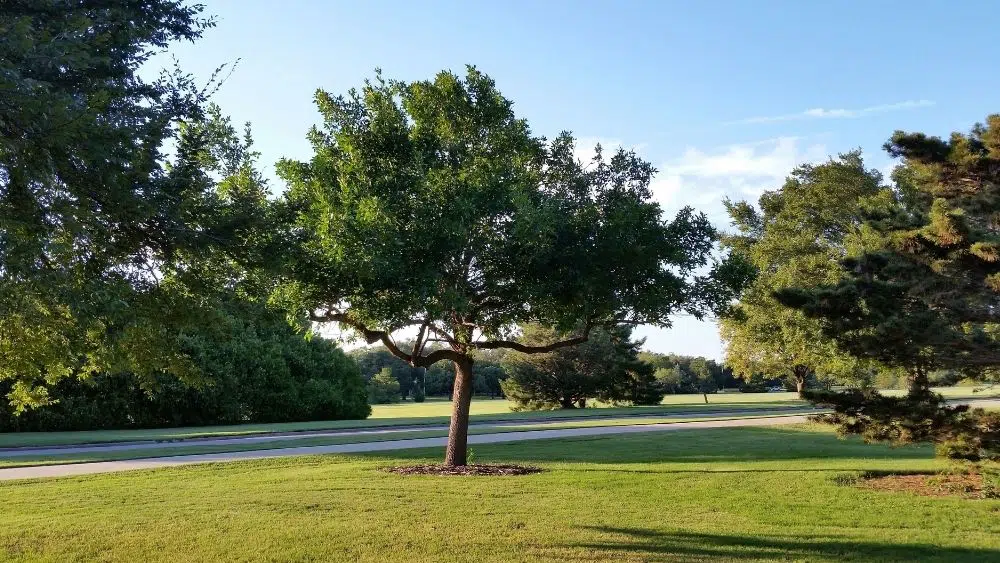
- Housing cost to income ratio: 3.05%
- Average childcare cost to income ratio: 1.31%
- Violent crime index: 27.1
- Nonviolent crime index: 53.2
- Cost of living index: 74.5
Conveniently located between two major metropolitan areas, Dallas-Fort Worth and Oklahoma City, Wichita Falls is a family-oriented, close-knit community that is perfect for anyone moving to Texas. Nearly 150,000 people make Wichita Falls their North Texas home. A lower cost of living, strong economy, and friendly demeanor draw people to this area.
Wichita Falls is served by the Wichita Falls Independent School District, which is the 30th-largest school district in Texas. If you prefer you can choose a private school like Wichita Falls Christian Academy, Faith Christian School, and St. Mary’s Catholic School as well as a few college campuses. Midwestern State University, Vernon College, and Wichita Falls Bible College are higher ed institutions offering a variety of academic programs.
Various hospitals serve the residents of the city including the United Regional Health Care System, Sheppard Air Force Base Hospital, and the Wichita Falls Veterans Administration Medical Center. Along with great hospitals, find a strong economy boosted by employers like Midwestern State University, General Electric, Lockheed Martin, and Sheppard Air Force Base.
The weather in Wichita Falls averages two inches of snow, 31 inches of rain, and 240 sunny days per year. The residents take full advantage of the hot summers by hosting the Hotter’N Hell Hundred bike ride every August that draws around 13,000 cyclists. The ride embraces the heat and Wichita Falls’ Bronze Level bicycle-friendly status. Outdoor enthusiasts will appreciate the Wichita Mountains Wildlife Refuge with its bison, elk, and prairie dogs. The Lucy Park Zoo is a great spot to make family memories. Get out and enjoy the fresh air at Lake Wichita for fun fishing and boating adventures. Enjoy a round of golf at Wichita Falls Municipal Golf Course. Swimming, disc golf, and hiking are some other fun activities.
Many community events and festivals celebrate everything from holidays to music and more. Aircraft displays and aerial demonstrations are impressive at the Wichita Falls Air Force Base Air Show. Find just what you need for gardening and landscaping at the Wichita Falls Home and Garden Show. Don’t miss out on the revelry at the Wichita Falls Railroad Festival and the Wichita Falls Country Music Festival.
Some noteworthy museums will enlighten you on art and Greek and Roman artifacts. Check out the Midwestern State University Museum of Art and the J. Paul Getty Museum at Midwestern State University. Kell House Museum is a historic Victorian mansion. Learn more about the history of railroads at the Wichita Falls Railroad Museum.
Wichita Falls is a great place to live, work, and raise a family. Make this friendly Texas city your new home.
5. Corpus Christi, Texas
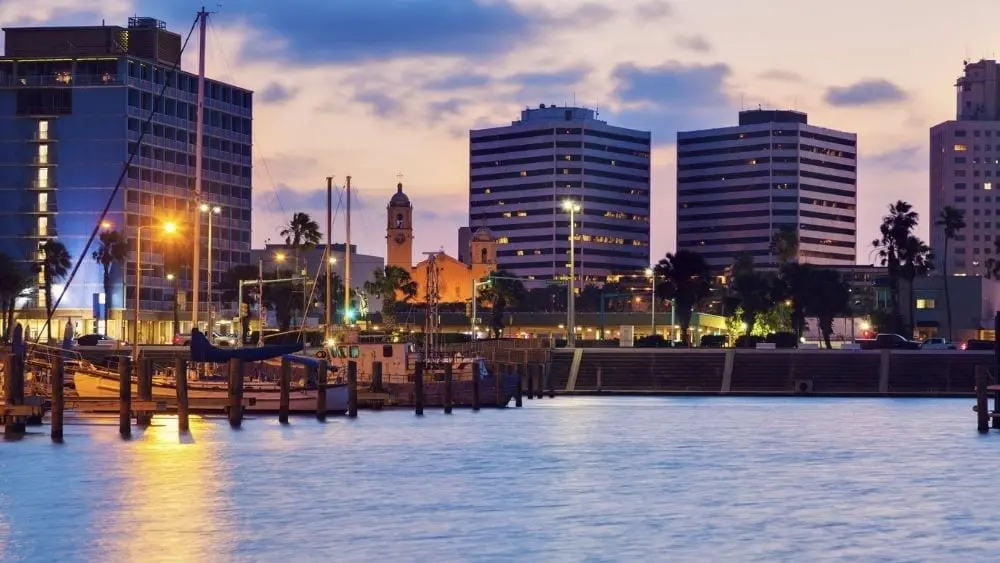
- Housing cost to income ratio: 3.09%
- Average childcare cost to income ratio: 1.21%
- Violent crime index: 35
- Nonviolent crime index: 56
- Cost of living index: 83.1
If you love the beach, Corpus Christi is the place for you! This Southern coastal city in Texas is laced with beaches, bays, and rivers that are sure to satisfy all your outdoor wants and needs. From sunbathing to fishing to kite surfing, this Texas locale has much to offer residents. Corpus Christi is a coastal city of over 320,000 people located in South Texas. It is the seat of Nueces County and is known for its mild climate and its affordable cost of living. Corpus Christi is also a popular tourist destination, with attractions such as the Texas State Aquarium, the USS Lexington Museum on the Bay, and the Selena Museum.
The major employers in this area come from tourism, energy, healthcare, manufacturing, and military industries. Excellent employment opportunities can be found at several hotels, oil and gas companies, hospitals, Reynolds Aluminum, the Naval Air Station Corpus Christi.
Corpus Christi receives about 33 inches of rain, zero inches of snow, and has 223 sunny days per year, meaning this Sparkling City by the Sea is always open for activities on the water and land. Enjoy the sandy beaches with family or friends.
Life in the Sparkling City by the Sea translates to fun festivals and events including the Corpus Christi Buccaneer Days with fireworks and family-friendly activities, the Corpus Christi Bayfest, the highly anticipated Corpus Christi Sandblast Festival, and holiday festivities.
Texas State Aquarium, the USS Lexington Museum on the Bay, and the Selena Museum are all big tourist draws aside from the welcoming Texas waters. The Corpus Christi Museum of Science and History and the South Texas Botanical Gardens & Nature Center are two other explorations. The Corpus Christi Seawall spans 1.75 miles along the Gulf Coast. Kayak or canoe the Corpus Christi Bay. Hike and bike at Padre Island National Seashore. Enjoy a round of golf at the Corpus Christi Country Club.
Discover delectable seafood at the many restaurants in Corpus Christi. Some local favorites include the shrimp, fish, and oysters at Doc’s Seafood and Steaks, the Saltwater Grill, and Black Diamond Oyster Bar.
Families moving to Corpus will find the 20th-largest school district in Texas, Corpus Christi ISD, as well as several private schools like John Paul II High School, St. Pius X Catholic School, and Incarnate Word Academy. Choose from colleges and universities like Texas A&M University-Corpus Christi, Del Mar College, Corpus Christi College, and South Texas College. Along with great educational opportunities, discover excellent healthcare in this area with the Christus Spohn Health System, the Driscoll Children’s Hospital and Corpus Christi Medical Center-Bay Area.
Corpus Christi is a great place to live, work, and raise a family. It offers a mild climate, a variety of outdoor recreation opportunities, and an affordable cost of living. Corpus Christi and its surrounding suburbs like Portland, Rockport, and Bishop are quickly expanding, and the liberal-leaning political scene makes the community welcoming and accepting to all new residents and visitors.
6. Texarkana, Texas
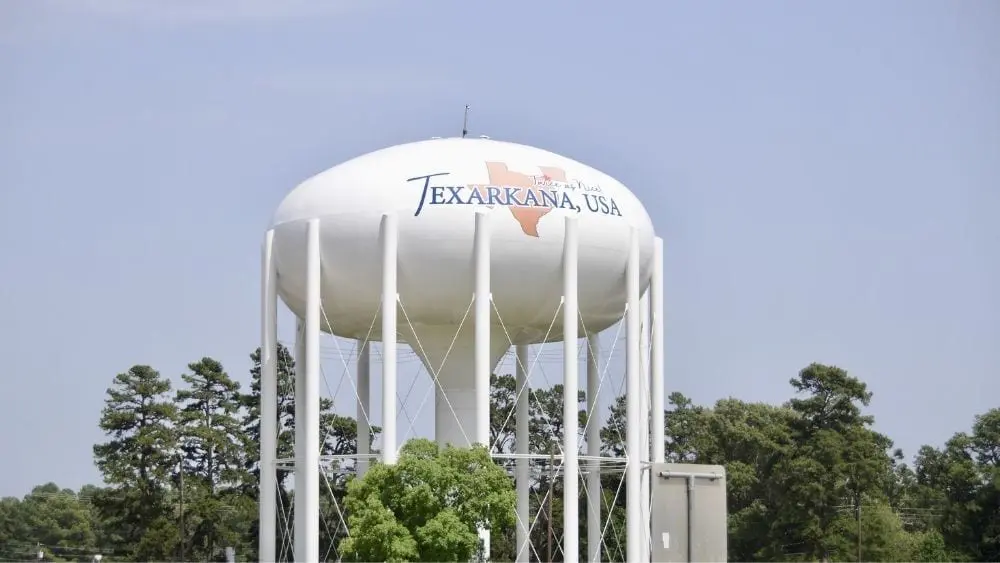
- Housing cost to income ratio: 2.83%
- Average childcare cost to income ratio: 1.27%
- Violent crime index: 46.4
- Nonviolent crime index: 75.9
- Cost of living index: 76.8
Texarkana is a unique city located in both Texas and Arkansas! This twin city straddles the border between the two states and fully embraces the unusual situation with entertaining landmarks like a city hall that is split down the middle. Home to 35,000 people, this inviting city is rich in history.
Suburbs like Red Lick, Wamba, and Texarkana North populate this Texas city. This somewhat conservative city values its residents and is proud of its friendly atmosphere. Families have access to any of the 12 hospitals in the area and a variety of schools including the Texarkana Independent School District, which is the 27th-largest school district in Texas. Private schools found here include Trinity Christian School, St. Mary of the Pines Academy, and Pleasant Grove Christian Academy. Texarkana is home to Texarkana College, a community college with over 7,000 students. Other higher education options offered here are Texas A&M University-Texarkana Higher Education Center and the University of Arkansas-Texarkana Higher Education Center.
Texarkana averages about 2 inches of snow, 51 inches of rain, and 213 sunny days per year. With weather like this, it is easy to find yourself enjoying the public parks, walking the trails, or fishing in the public lakes. Texarkana Lake is a fun spot to boat and fish. Stay active playing disc golf at the Texarkana Disc Golf Park or swimming at the Texarkana Aquatic Center. Play frequent rounds of golf at the Texarkana Country Club.
The City on the Line is filled with fun, recreation, and entertainment. Visit the Texarkana Museums System, including the Museum of Regional History, the Texarkana Railroad Museum, and the Ace of Diamonds Museum. Take in a show at the Perot Theatre, a historic theater that hosts a variety of performances. Families love to see the more than 200 animals from around the world at the Texarkana Zoo. Want to learn more about the two states? Visit the Texarkana Arkansas-Texas State Line Museum.
Texarkana has a diversified economy that is supported by major industries, including manufacturing with key players such as Cooper Tire & Rubber and General Dynamics. Healthcare is a vibrant boost to the economy with hospitals and healthcare providers like Texarkana Medical Center and Christus St. Michael Health System. From tourism to education, employment opportunities run the gamut.
Texarkana, also known as The Ark-La-Tex Crossroads, hosts fun festivals and events to foster a strong sense of community. The Texarkana Arkansas-Texas State Fair has fun, food vendors, games, rides, and live music. The Texarkana Blues Festival brings the focus on blues music from local and national musicians. Celebrate the holidays at the Texarkana Christmas Festival with a parade, fireworks, and other holiday-themed activities.
Texarkana is a great place to live, work, and raise a family. It offers a strong economy, a variety of outdoor recreation opportunities, and a friendly community. With new homebuilders creating a variety of styles and price points, you can enjoy a great quality of life in this area.
7. Laredo, Texas
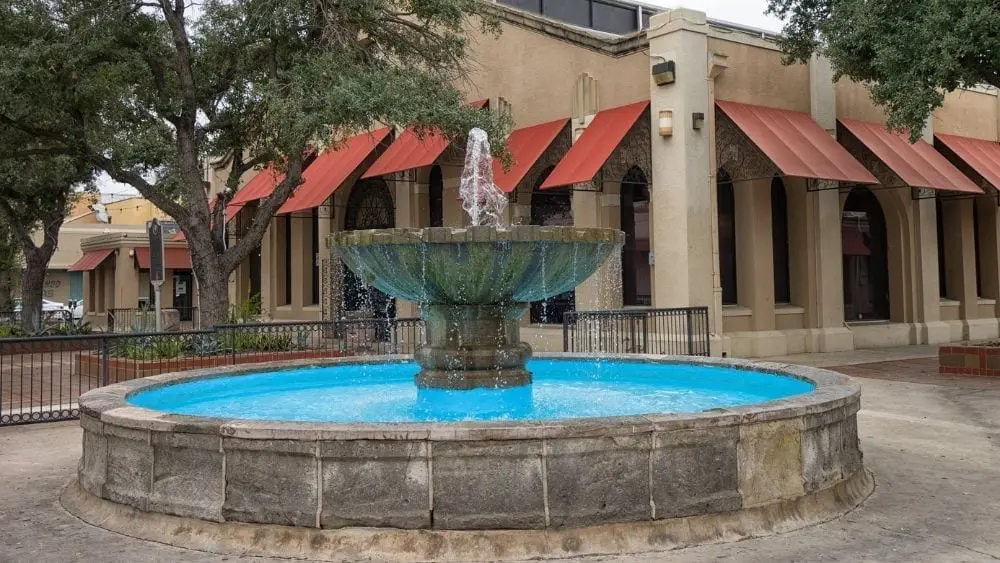
- Housing cost to income ratio: 2.90%
- Average childcare cost to income ratio: 1.24%
- Violent crime index: 26.2
- Nonviolent crime index: 48.7
- Cost of living index: 84
Laredo is located at the southern border of Texas on the bank of the Rio Grande. Laredo is a city of over 257,000 people and is part of Webb County. Laredo is a major port of entry for trade between the United States and Mexico. Known for its rich history, its strong economy, and its friendly people, Laredo is also a popular tourist destination. Looking for fun things to do? Visit the Laredo Center for the Arts, which features a variety of art exhibits, performances, and classes. Explore some interactive exhibits focused on science, technology, engineering, and art at the Laredo Children’s Museum. See the views of the Rio Grande and sister city, Nuevo Laredo, Mexico from the Laredo International Bridge.
This border town averages 21 inches of rain, zero inches of snow, and 220 sunny days per year. During those sunny days, residents take their families to one of the local pools or splash parks to beat the heat. Or they may spend the day fishing in one of the many lakes and rivers that wrap around the city including Lake Casa Blanca. Take a walk or bike ride on the Laredo Riverfront Trail, which offers a scenic route along the Rio Grande River. Golf at the Laredo Country Club. Enjoy some outdoor time hiking or biking at Laredo International Park.
Revelry is always in store in this part of the state. From food to holidays to culture, the festivals in Laredo are unparalleled. The annual Washington’s Birthday Celebration has family-friendly activities, a parade, and fireworks. Dancing, food, and music bring the Mexican holiday celebration, the Cinco de Mayo Festival to life. Beautiful balloons from around the world are seen at the Laredo International Balloon Festival. The holidays are complete with the fun floats, marching bands, and holiday-themed attractions at the Laredo Christmas Parade. Laredo also welcomes all members of the bird-watching community to their trails to observe the hundreds of species that call it home. It also hosts the Laredo Birding Festival every year to highlight the rivers, trails, and ranches that attract these birds.
The economy is strong with industries like manufacturing, healthcare, and education adding to the economy. Some of the larger employers in the area include Delphi Automotive, Raytheon, and BAE Systems. This senior-friendly area is filled with great healthcare providers and hospitals like Laredo Medical Center, Laredo Children’s Hospital, and Doctors Hospital of Laredo.
Public and private schools are ready to serve your family. The Laredo Independent School District is the 26th-largest school district in Texas. St. Joseph Academy, Laredo Christian School, and Alexander International Academy are some of the choices you have if you prefer a private school option. Texas A&M International University, a public university with over 8,000 students, makes its home in the Gem of the Border. Serving 10,000+ students, Laredo Community College is another popular school.
The Laredo Farmers Market is filled with fresh smells and flavors of produce, baked goods, and more. Laredo has its share of authentic Mexican food as well as traditional American cuisine. Local restaurants offer delicious meals. Try the Border Foundry Restaurant & Bar, El Capataz, and Taco Palenque. The Gateway City has plenty of delicious food to satisfy any hunger.
Laredo’s moderately liberal political climate keeps the community close-knit and friendly. Neighborhoods like San Isidro, Del Mar Hills, and La Bota Ranch are all buzzing with Texas small-town charm. Take a look at the new home offerings in and around Laredo.
8. Victoria, Texas
- Housing cost to income ratio: 3.02%
- Average childcare cost to income ratio: 1.20%
- Violent crime index: 21.4
- Nonviolent crime index: 50.6
- Cost of living index: 85.4
Known as the Crossroads of South Texas, Victoria is located at the intersection of three major highways giving easy access to other Texas cities with just a short drive. Also called the Home of the Golden Crescent and the City of Two Rivers, Victoria is a strongly conservative city that offers a diverse and welcoming atmosphere.
Residents will feel secure knowing there are a couple of hospitals that service the area. Hospitals in the Victoria area include DeTar Healthcare System and Citizens Medical Center. The Victoria Independent School District along with Victoria College provide outstanding educational opportunities for your family.
Victoria prides itself on being at the forefront of new businesses and technology; its manufacturing and chemical plants attract new residents and their high-speed fiber optics are making work and play a little easier for everyone. Build a career at some of the major employers such as Dow Chemical, Formosa Plastics, DeTar Healthcare System, the City of Victoria, and Victoria County.
Victoria gets about 41 inches of rain, zero inches of snow, and 202 sunny days annually. This gives residents plenty of opportunities to visit Coleto Creek Reservoir & Park for fishing, camping, and a refreshing swim. Or they may want to explore Texas history by visiting the Fannin Battleground State Historic Site or the Presidio La Bahia. The Guadalupe River runs through Victoria and offers a variety of outdoor recreation opportunities, including fishing, kayaking, and tubing. The Victoria Nature Center features a variety of activities, including hiking, biking, and birdwatching. Take a stroll through the Victoria Rose Garden showcasing over 1,000 rose bushes. Take in a minor league baseball game and cheer on the Victoria Generals. Other fun activities include the Victoria Livestock Show & Rodeo, Christmas in the Crossroads, and the Victoria Crossroads Festival.
Looking for delicious meals? Local restaurants will wow the taste buds with tasty barbecue at Schroeder’s BBQ & Icehouse. Enjoy savory sauces, steaks, and seafood at Baytown Seafood & Steak. You will find locals at the Victoria Sandwich Shop, the Republic Café, and the La Bahia Bar & Grill.
The affordable cost of living, friendly vibe, and great weather make the oldest city in South Texas a big contender for anyone wanting to live in a great Texas city. With job opportunities, a family-friendly community and a good location, the new homes in Victoria will impress. Start the journey to finding the perfect new home for your family in the Victoria area today.
9. Killeen, Texas
- Housing cost to income ratio: 3.05%
- Average childcare cost to income ratio: 1.57%
- Violent crime index: 30.8
- Nonviolent crime index: 44.4
- Cost of living index: 78.5
Located in Central Texas, Killeen is a family-friendly city that is geared toward being accessible and welcoming for families young and old. The proximity to the Fort Cavazos (formerly Fort Hood) military base brings in new residents and provides many job opportunities. Killeen is a city of over 162,000 people located about halfway between Austin and Waco. It is the seat of Bell County. Home to one of the largest military bases in the world, Killeen is an ideal Texas setting for diverse families, young professionals, and retirees.
This city is liberal leaning when it comes to politics and has a diverse community of people displaying a small Texas town’s big heart. Young families with children will be happy to find excellent schools to choose from. The Killeen Independent School District, which is the 24th-largest school district in Texas, employs more than 6,800 staff and serves 44,000 students. Focused on student success, this district has award-winning programs, college and career opportunities, and excellent extracurricular events. Private schools in the city include Covenant Christian Academy, Faith Academy, and St. Joseph School. College bound students can attend Central Texas College, a community college with over 10,000 students. The city is also home to the Texas A&M University-Central Texas Higher Education Center and the University of Mary Hardin-Baylor Higher Education Center.
Killeen’s strong economy is driven largely by Fort Cavazos which employs 40,000+ people. Other employers include Seton Healthcare Family, Central Texas College, Amazon, GEICO, Humana, and an array of small businesses. An affordable cost of living is another great draw for potential new homebuyers in Killeen. Additionally, healthcare providers here provide both in-patient and out-patient care at Seton Medical Center Killeen, Carl R. Darnall Army Medical Center, and the Metroplex Health System Killeen.
Central Texas enjoys great weather. On average, Killeen has 33 inches of rain, zero inches of snow, and 229 sunny days per year. The city offers many activities for kids and adults to enjoy during those good weather days like art centers, libraries, public parks, and splash pads. Take a swim at the Killeen Community Center, which features a water park, lazy river, and fitness center.
There are plenty of retailers from major box stores to warehouse stores to antique stores and thrift shops. The diverse population translates to a variety of dining options. Enjoy international cuisine, comfort food, food trucks, and more. One quirky menu item at Galaxy B & G is the delicious Galactic Madness, 2 burger patties sandwiched between two grilled cheese sandwiches serving as buns. This Star Wars themed restaurant has a variety of fun themed items for sale as well. From sushi to burritos to fried rice, and sandwiches, the delectable offerings in Killeen will satisfy any hunger pang.
The City of Soldiers has its share of festivals and fun. The Killeen Funfest, the Killeen Veterans Day Parade, and the Killeen Christmas Parade are a few events with carnival rides, live music, bands, and attractions. Don’t miss out on the stunning holiday lights drive through nearby Blora. It will be an annual event for your family. Stillhouse Hollow Lake is full of boats fishing for bass. Find everything from hiking trails to disc golf to golfing in this vibrant city.
Give Killeen some serious consideration as your new home locale. With great new homebuilders, a strong economy, and an affordable cost of living, it all adds up! Check out some of the new homes in the area.
10. Sherman-Denison, Texas
- Housing cost to income ratio: 3.76%
- Average childcare cost to income ratio: 1.43%
- Violent crime index: 20.9
- Nonviolent crime index: 44.5
- Cost of living index: 80.3
The Sherman-Denison metropolitan area, located just north of the Dallas-Fort Worth area, is growing rapidly. This metropolitan area is known for its vibrant manufacturing industry and is an ideal place for businesses to grow and expand. Living close to the Metroplex provides an array of attractions, restaurants, services, and entertainment. The convenient location of this metropolitan area gives all the adjacent cities, like Gainesville, Gunter, and Knollwood, the ability to retain their small-town charm but still have the amenities and perks of big cities within reach.
Some of the benefits of living in the Sherman-Denison area include an affordable cost of living as compared to other major cities, a strong economy with a variety of industries like manufacturing, healthcare, and education, as well as employment opportunities. Major employers include Tyson Foods, Raytheon, Johnson Controls, and Austin College. This family-friendly community is served by two school districts, Denison Independent School District and Sherman Independent School District. Austin College is a private liberal arts college with outstanding graduate programs. The Texoma Medical Center and Wilson N. Jones Regional Medical Center are two noteworthy hospitals serving the area.
Residents can expect an average of 42 inches of rain, one inch of snow, and 227 sunny days. This mild climate allows for easy outdoor recreation. Get out to fish, boat, swim, and camp at Lake Texoma. This large reservoir is great for family outings. Enjoy Eisenhower State Park on the shores of this lake. Hike and bike to take in your surroundings. Another fishing spot is Denison Dam. Sherman Municipal Park is a local favorite.
There are plenty of delicious eateries in the area ready to tempt you with comfort food, barbecue, steaks, and more. El Rancho Grande, Black Walnut Café, and Chaco’s Restaurant are a few local favorites. You will also find tasty treats at some of the community events and festivals. Music lovers will love the tunes at the Sherman Jazz Festival. Enjoy all the fall revelry at the annual Denison Oktoberfest. The holidays are a little brighter with the Sherman Christmas Parade. Overall, the Twin Cities area is a great place to live, work, and raise a family. It offers a strong economy, affordable cost of living, family-friendly community, and mild climate. You can start your new homeownership journey by perusing some of the great new home designs in the Sherman-Denison area.
This list was compiled using statistics for cost of living, average housing costs, average childcare costs, and crime indices.

Jessi Gonzalez writes on the topics of home-buying, home decor, and home-ownership for New Home Source. She has a degree from Coastal Bend College and is currently enrolled in the English degree program at Texas A&M Corpus Christi.
 How to Build a House in Arkansas
How to Build a House in Arkansas
James
More like
1. Dallas-Fort Worth
2. Austin
3. San Antonio
4. Houston
5. Waco
6. Bryan-College Station
7. Tyler
8. Lubbock
9. Amarillo
10. Midland-Odessa